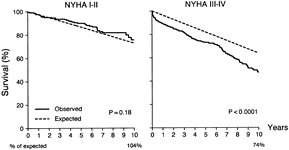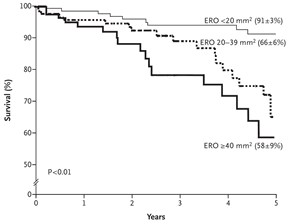Indications for Surgery
Factors determining timing of surgery for degenerative mitral regurgitation in the current American College of Cardiology and American Heart Association guidelines include symptoms, left ventricular (LV) ejection fraction (EF), LV end-systolic dimension (LV ESD), atrial fibrillation, and pulmonary hypertension1. All patients who have any symptoms and moderate or severe mitral regurgitation should be referred for surgical treatment. It is preferable to operate on patients early in their symptomatic course, as long term survival following mitral valve repair is compromised in patients with New York Heart Association Class III or IV symptoms (see Figure 1)2. Patients with lesser degrees of regurgitation in the presence of symptoms will often be found to have increased mitral regurgitation, or inadequate increase in ejection fraction, on stress echocardiography and should also be referred for surgical consideration3. Asymptomatic patients with left ventricular dilatation (LV end systolic diameter more than 45 mm), decreased Ejection Fraction (<60%), atrial fibrillation or pulmonary hypertension (PA systolic pressure > 50 mm Hg at rest or > 60 mm Hg with exercise) should also be considered for elective mitral valve surgery. When following patients with asymptomatic moderate to severe mitral regurgitation, one should pay particular attention to serial ejection fraction, as a drop to <60% confers poorer long term survival even with successful mitral valve repair (Figure 2)4.
Many cardiologists are moving towards liberal application of mitral valve repair in all asymptomatic patients with severe mitral regurgitation. It is well established that most patients with moderate to severe mitral regurgitation will develop an indication for elective mitral valve surgery within a decade of follow-up. Many opinion leaders now argue it is best to undertake surgery before symptoms or any evidence of LV dysfunction ensues5, 6. This position was reinforced in a recent report by Enriquez-Sarano and colleagues, whom reported on the clinical outcomes of 456 patients with quantitatively assessed mitral regurgitation, followed to a mean of 31 months and referred for surgery according to guidelines. They found that patients with severe quantitative mitral regurgitation (effective regurgitant orifice of at least 40 mm2) had significant morbidity including increased mortality during follow up (Figure 3) and concluded that such patients should be considered for prompt cardiac surgery7. Another recent article by Rosenhek and colleagues provides a different perspective8. They followed 132 patients with asymptomatic severe mitral regurgitation for a mean time of 62 months and did not find the observed survival to differ from expected survival, with thirty eight patients developing indications for elective surgery according to guidelines. In our current practice we offer surgery to all symptomatic patients and also generally to all asymptomatic patients with severe mitral regurgitation.
(*) Modified from Tribouilloy CM, Enriquez-Sarano M, Schaff HV, et al: Impact of preoperative symptoms on survival after surgical correction of organic mitral regurgitation: rationale for optimizing surgical indications. Circulation 99 (3):400-5, 1999. Lippincott Williams & Wilkins
(**) Modified from Enriquez-Sarano M, Tajik AJ, Schaff HV, et al: Echocardiographic prediction of survival after surgical correction of organic mitral regurgitation. Circulation; 90(2):830-7, 1994. Lippincott Williams & Wilkins
(***) Modified from Enriquez-Sarano M, Avierinos JF, Messika-Zeitoun D, et al: Quantitative determinants of the outcome of asymptomatic mitral regurgitation. New Engl J Med 352(9):875-83 2005. Copyright © 2005 Massachusetts Medical Society. All rights reserved.
- 1 Bonow RO, Carabello B, de Leon AC et al. ACC/AHA Guidelines for the Management of Patients With Valvular Heart Disease. Executive Summary. A report of the American College of Cardiology/American Heart Association Task Force on Practice Guidelines (Committee on Management of Patients With Valvular Heart Disease). J Heart Valve Dis 1998 November;7(6):672-707.
- 2Tribouilloy CM, Enriquez-Sarano M, Schaff HV et al. Impact of preoperative symptoms on survival after surgical correction of organic mitral regurgitation: rationale for optimizing surgical indications. Circulation 1999 January 26;99(3):400-5.
- 3Wu WC, Aziz GF, Sadaniantz A. The use of stress echocardiography in the assessment of mitral valvular disease. Echocardiography 2004 July;21(5):451-8.
- 4 Enriquez-Sarano M, Schaff HV, Orszulak TA, Tajik AJ, Bailey KR, Frye RL. Valve repair improves the outcome of surgery for mitral regurgitation. A multivariate analysis. Circulation 1995 February 15;91(4):1022-8.
- 5Hayek E, Gring CN, Griffin BP. Mitral valve prolapse. Lancet 2005 February 5;365(9458):507-18.
- 6Enriquez-Sarano M. Timing of mitral valve surgery. Heart 2002 January;87(1):79-85.
- 7 Enriquez-Sarano M, Avierinos JF, Messika-Zeitoun D et al. Quantitative determinants of the outcome of asymptomatic mitral regurgitation. N Engl J Med 2005 March 3;352(9):875-83.
- 8 Rosenhek R, Rader F, Klaar U et al. Outcome of watchful waiting in asymptomatic severe mitral regurgitation. Circulation 2006;113:2238-2244.



